Contents
- 1 #1 HOW to clean and disinfect COVID-19 correctly
- 2 Hygiene
- 2.1 Home and everyday hygiene
#1 HOW to clean and disinfect COVID-19 correctly
In this outbreak of coronavirus, it’s essential to avail precautionary measures to keep the house environment secure and healthy. You need to set your primary concentrate on cleaning the regularly touched goods and products.
And, to help make the areas germs and dirt free of charge, choose to disinfect the areas. As frequently clearing won’t enable you to avoid the spread of viruses. You have to regularly clean their hands to remain healthy and safe.
And, don’t forget to completely clean the inaccessible corners of your property, as possible the breeding floor for germs. You may take professional assistance from the very best and best cleaning solutions at your residential locations.
Essential Cleaning Ideas to Get a Safe and sound and Hygienic Environment
Keeping in mind all of your safety concerns and also to avoid the spread of COVID-19, you need to provide extra attempts to completely disinfect the areas of your home.
- Disinfect the home
First and foremost, Stay away from the utilization of chemical substance solutions while washing, as possibly hazardous to your wellbeing.
Utilizing the right disinfectants may avoid dirt, and grimes, the many renowned and recommendable Washing services in Dubai make use of proper gear and disinfectants to completely clean the surfaces.
- Focus on Frequently Touched Items
So,
Table, remotes, the sink, and other needed things. Beginning with wiping to keeping a deep washing regime can be more than effective.
- Disinfect the Soft Surfaces
Washing and disinfecting the soft regions of the house areas are necessary. This consists of blankets or carpets which may be challenging. So, it’s essential to take professional help for cleaning solutions in Dubai, in eliminating dirt, dust, and challenging stains.
But, through the use of suitable solutions, predicated on the manufacturer’s guidelines, and if it’s required, by making use of the hot water, you can clean the areas. Lastly, be sure you dry them.
- Wash THE HANDS Frequently
To stay secure and healthy, try avoiding utilizing regular soaps and utilising the right-hand washers to keep the hands germ-free.
If you’re going outside your home for your necessary functions, be sure you have washed your hands after coming house. Maintain a safe length from those who are sick or coughing. Remain safe by availing of reliable
Mr Meticulous Cleaning has been in the same family for now over 25 years. We are servicing all of Sydney and its suburbs.
Mr Meticulous Cleaning’s manager is Marc Hamilton, and as owner and director from 1995 to 2020 this year you will be in no better hands. This year 2020 with all the Fires – floods and COVID-19 pandemic and us all being locked in – locked down, the time has never been more severe to get our homes, health, and work environments right – sterilised and hygienically attended to by trained and responsible cleaners. Marc always states, that 2020….. that’s the year we get health and hygiene RIGHT.
Mr Meticulous Cleaning is a premium cleaning services company with a highly trained and skilled team of cleaners who service the inner and more full Sydney area. Mr Meticulous Cleaning specialises in both house cleaning, bringing the sparkle back into your home, and office cleaning, which includes such entities as daycare centres, strata buildings, schools, clubs and any size of office.
We are skilled in commercial cleaning, and we will provide our services as a needed requirement. We also offer standalone or combined carpet cleaning and window cleaning for both the home and any commercial building. Mr Meticulous Cleaning has been helping its customers with their cleaning needs for 25 years, and maintains the highest standards of cleaning, using non-toxic, environmentally friendly cleaning products.
Our team of trained cleaners maintain the reputation and attitude of Mr Meticulous Cleaning, offering you the highest standard of cleaning with a positive, non-intrusive approach.
To receive a quote, or book your clean with us, in 9904 1905. or easier by [email protected]
Mr Meticulous Cleaning has offered home cleaning services in Sydney for 25 years, with many long-term happy clients.
No job is too big or too small, and we are unique in that our team of cleaners care personally about providing you with excellent cleaning results, as opposed to just being there to do a job.
We would love to welcome you as a Customer and invite you to call us for a quote, or to book us on 9904 1905. We will respond to any enquiries on the same day. [email protected]
Mr Meticulous Cleaning –Sydney, will put the sparkle back into your home – office!
Office Cleaning Services in Sydney
At Mr Meticulous Cleaning, our range of specialised services include Office Cleaning Sydney. We have trained our cleaners to be skilled in the cleaning requirements of any Office environment, ensuring you receive a thorough and clean result. Marc from Mr Meticulous Cleaning states, that it’s no longer good enough to dust and place the dishwasher on and lightly clean a hand basin and call a workplace clean. You need to get in, use modern cleaning chemicals that eat bacteria, destroy spells, and eliminate smells. If you are ready for a service that is more than moving coffee cups, then get in touch with us.
We will tailor our office cleaning services to your specific needs. Having first inspected your premises and spoken with you about what it is you are looking for. Our quote will be competitive and is accompanied by a 100% Customer Satisfaction Guarantee.
End Of Lease Cleaning Services Sydney
Mr Meticulous Cleaning is the preferred end-of-lease cleaning company in Sydney – ensuring a prompt and professional exit clean once a tenant has moved out.
Mr Meticulous Cleaning understands the importance of providing a spick and span, detailed clean before new tenants are to move in.
Property owners Property managers and former Tenants can feel confident that they will receive a cleaning result that will make the transition smooth to exiting and doing the correct clean, and thus help to get the BOND monies refunded. , The new tenants moving in, and the previous tenants in their bid to receive their bond back.
For that stress-free end-of-lease experience, you can trust us at Mr Meticulous Cleaning Services Sydney.
Bedrooms and Living Area Cleaning, Carpet Cleaning, Bathroom Cleaning, Cleaning of Walls, Vacuuming, Mopping, Wet Areas Professionally Cleaned, Mould, Removal, Kitchen Cleaning, Oven Cleaning, Balcony Cleaning, Blind Cleaning, Ceiling & Eaves Cleaning.
Real estate investors can feel more secure about their investment properties after receiving a complete cleaning makeover as their tenant transitions.
There is no match for the professional dedication and finished results from our end-of-lease cleaning services in Sydney. Our team have been trained to have an eye for detail and a personal standard of excellence.
Call Mr Meticulous Cleaning, End Of Lease Cleaning Sydney on 9904 1905, whether you are the Tenant, Property owner or Property manager, and obtain a competitive quote tailored to your specific needs.
In Sydney, in 2020, we now have cleaners in these areas to help you with your home and office. Get in touch now.
#1 HOW to clean and disinfect COVID-19 correctly
Hygiene
Jump to navigationJump to search

Poster to raise awareness about the importance of clean water for good hygiene, for use in Islamic countries.[1]
Hygiene is a series of practices performed to preserve health. According to the World Health Organization (WHO), “Hygiene refers to conditions and practices that help to maintain health and prevent the spread of diseases.”[2] Personal hygiene refers to maintaining the body’s cleanliness. Hygiene activities can be grouped into the following: home and everyday hygiene, personal hygiene, medical hygiene, sleep hygiene and food hygiene. Home and everyday hygiene include hand washing, respiratory hygiene, food hygiene at home, hygiene in the kitchen, hygiene in the bathroom, laundry hygiene and medical hygiene at home.
Many people equate hygiene with ‘cleanliness,’ but hygiene is a broad term. It includes such personal habit choices as how frequently to take a shower or bath, wash hands, trim fingernails, and wash clothes. It also includes attention to keeping surfaces in the home and workplace clean, including bathroom facilities. Some regular hygiene practices may be considered good habits by society, while the neglect of hygiene can be considered disgusting, disrespectful, or threatening.
Home and everyday hygiene
Home hygiene overview
Home hygiene pertains to the hygiene practices that prevent or minimize the spread of disease at home and other everyday settings such as social settings, public transport, the workplace, public places, etc.
Hygiene in a variety of settings plays an important role in preventing the spread of infectious diseases.[9] It includes procedures used in a variety of domestic situations such as hand hygiene, respiratory hygiene, food and water hygiene, general home hygiene (hygiene of environmental sites and surfaces), care of domestic animals, and home health care (the care of those who are at greater risk of infection).
At present, these components of hygiene tend to be regarded as separate issues, although based on the same underlying microbiological principles. Preventing the spread of diseases means breaking the chain of infection transmission. Simply put, if the chain of infection is broken, the infection cannot spread. “Targeted hygiene” is based on identifying the routes of pathogen spread in the home and introducing hygiene practices at critical times to break the chain of infection.[10] It is using a risk-based approach based on Hazard Analysis Critical Control Point (HACCP).
The main sources of infection in the home are people (who are carriers or are infected), foods (particularly raw foods), water, pets and domestic animals.[11] Sites that accumulate stagnant water—such as sinks, toilets, waste pipes, cleaning tools, face cloths, etc. readily support microbial growth and can become secondary reservoirs of infection, though species are mostly those that threaten “at risk” groups. Pathogens (potentially infectious bacteria, viruses etc.—colloquially called “germs”) are constantly shed from these sources via mucous membranes, feces, vomit, skin scales, etc. Thus, when circumstances combine, people are exposed, either directly or via food or water, and can develop an infection.
The main “highways” for the spread of pathogens in the home are the hands, hand and food contact surfaces, and cleaning cloths and utensils (e.g. fecal-oral route of transmission). Pathogens can also be spread via clothing and household linens, such as towels. Utilities such as toilets and wash basins, for example, were invented for dealing safely with human waste but still have risks associated with them. Safe disposal of human waste is a fundamental need; poor sanitation is a primary cause of diarrhea disease in low-income communities. Respiratory viruses and fungal spores are spread via the air.
Good home hygiene means engaging in hygiene practices at critical points to break the chain of infection.[10][11] Because the “infectious dose” for some pathogens can be very small (10-100 viable units or even less for some viruses), and infection can result from the direct transfer of pathogens from surfaces via hands or food to the mouth, nasal mucous or the eye, ‘hygienic cleaning’ procedures should be sufficient to eliminate pathogens from critical surfaces.
Hand washing
Hand washing (or handwashing), also known as hand hygiene, is the act of cleaning one’s hands with soap or handwash and water to remove viruses/bacteria/microorganisms, dirt, grease, or other harmful and unwanted substances stuck to the hands. Drying of the washed hands is part of the process as wet and moist hands are more easily recontaminated.[12][13] If soap and water are unavailable, hand sanitiser that is at least 60% (v/v) alcohol in water can be used instead, unless hands are visibly excessively dirty or greasy.[14][15] Hand hygiene is central to preventing the spread of infectious diseases in home and everyday life settings.[16]
The World Health Organization (WHO) recommends washing hands for at least 20 seconds before and after certain activities.[17][18] These include the five critical times during the day where washing hands with soap is important to reduce fecal-oral transmission of disease: after using the toilet (for urination, defecation, menstrual hygiene), after cleaning a child’s bottom (changing nappies), before feeding a child, before eating and before/after preparing food or handling raw meat, fish, or poultry.[19]
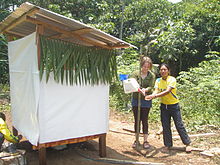
A tippy tap for handwashing after using a urine-diverting dry toilet in Pumpuentsa, Ecuador
Respiratory hygiene
Correct respiratory and hand hygiene when coughing and sneezing reduces the spread of pathogens, particularly during the cold and flu season.[9]
- Carry tissues and use them to catch coughs and sneezes, or sneeze into your elbow
- Dispose of tissues as soon as possible
Hygiene in the kitchen, bathroom and toilet
Routine cleaning of hands, food, sites and surfaces (such as toilet seats and flush handles, door and tap handles, work surfaces, bath and basin surfaces) in the kitchen, bathroom and toilet rooms reduce the spread of pathogens.[20] The infection risk from flush toilets is not high, provided they are properly maintained, although some splashing and aerosol formation can occur during flushing, particularly when someone has diarrhea. Pathogens can survive in the scum or scale left behind on baths, showers, and washbasins after washing and bathing.
Thorough cleaning is important in preventing the spread of fungal infections. Moulds can live on wall and floor tiles and shower curtains. Mould can be responsible for infections, cause allergic responses, deteriorate/damage surfaces, and cause unpleasant odours. Primary sites of fungal growth are inanimate surfaces, including carpets and soft furnishings.[21] Air-borne fungi are usually associated with damp conditions, poor ventilation, or closed air systems.
Hygienic cleaning can be done through:
- Mechanical removal (i.e., cleaning) using a soap or detergent. To be effective as a hygiene measure, this process must be followed by thorough rinsing under running water to remove pathogens from the surface.
- Using a process or product that inactivates the pathogens in situ. Pathogen kill is achieved using a “micro-biocidal” product, i.e., a disinfectant or antibacterial product; waterless hand sanitiser; or by application of heat.
- In some cases, combined pathogen removal with kill is used, e.g., laundering of clothing and household linens such as towels and bed linen.
Laundry hygiene
Laundry hygiene involves practices that prevent disease and its spread via soiled clothing and household linens such as towels.[22] Items most likely to be contaminated with pathogens are those that come into direct contact with the body, e.g., underwear, personal towels, facecloths, and nappies. Cloths or other fabric items used during food preparation, cleaning the toilet or cleaning up material such as feces or vomit are a particular risk.[11]
Microbiological and epidemiological data indicate that clothing and household linens etc. are a risk factor for infection transmission in home and everyday life settings as well as institutional settings. The lack of quantitative data linking contaminated clothing to infection in the domestic setting makes it difficult to assess the extent of this risk.[22][11][23] It also indicates that risks from clothing and household linens are somewhat less than those associated with hands, hand contact and food contact surfaces, and cleaning cloths, but even so, these risks need to be managed through effective laundering practices. In the home, this routine should be carried out as part of a multibarrier approach to hygiene which includes hand, food, respiratory and other hygiene practices.[22][11][23]
Infectious disease risks from contaminated clothing etc. can increase significantly under certain conditions, e.g., in healthcare situations in hospitals, care homes and the domestic setting where someone has diarrhoea, vomiting, or skin or wound infection. It increases in circumstances where someone has reduced immunity to infection.
Hygiene measures, including laundry hygiene, are an important part of reducing the spread of antibiotic-resistant strains.[24][25][26] In the community, otherwise healthy people can become persistent skin carriers of MRSA or faecal carriers of enterobacteria strains which can carry multi-antibiotic resistance factors (e.g. NDM-1 or ESBL-producing strains). The risks are not apparent until, for example, they are admitted to a hospital, when they can become “self infected” with their resistant organisms following a surgical procedure. As persistent nasal, skin or bowel carriage in the healthy population spreads “silently” across the world, the risks from resistant strains in both hospitals and the community increase.
[25] In particular, the data indicates that clothing and household linens are a risk factor for the spread of S. aureus (including MRSA and PVL-producing MRSA strains), and that effectiveness of laundry processes may be an important factor in defining the rate of community spread of these strains.[22][27] Experience in the United States suggests that these strains are transmissible within families and in community settings such as prisons, schools and sports teams. Skin-to-skin contact (including unabraded skin) and indirect contact with contaminated objects such as towels, sheets and sports equipment seem to represent the mode of transmission.[22]
During laundering, temperature and detergent work to reduce microbial contamination levels on fabrics. Soil and microbes from fabrics are severed and suspended in the wash water. These are then “washed away” during the rinse and spin cycles. In addition to physical removal, micro-organisms can be killed by thermal inactivation which increases as the temperature is increased. Chemical inactivation of microbes by the surfactants and activated oxygen-based bleach used in detergents contributes to the hygiene effectiveness of laundering. Adding hypochlorite bleach to the washing process achieves the inactivation of microbes. Several other factors can contribute including drying and ironing.
Drying laundry on a line in direct sunlight is known to reduce pathogens.[28]
In 2013 the International Scientific Forum on Home Hygiene (IFH) reviewed some 30 studies of the hygiene effectiveness of laundering at temperatures ranging from room temperature to 70 °C, under varying conditions.[29] A key finding was the lack of standardization and control within studies, and the variability in test conditions between studies such as wash cycle time, number of rinses, etc. The consequent variability in the data (i.e., the reduction in contamination on fabrics) obtained, in turn, makes it extremely difficult to propose guidelines for laundering with any confidence, based on currently available data. As a result, there is significant variability in the recommendations for hygienic laundering of clothing etc. given by different agencies.[30][31]
Medical hygiene at home
Medical hygiene pertains to the hygiene practices that prevent or minimize disease and the spreading of disease by administering medical care to those who are infected or who are more “at risk” of infection in the home. Across the world, governments are increasingly under pressure to fund the level of healthcare that people expect. Care for increasing numbers of patients in the community, including at home is one answer but can be fatally undermined by inadequate infection control in the home. Increasingly, all of these “at-risk” groups are cared for at home by a carer who may be a household member who thus requires a good knowledge of hygiene. People with reduced immunity to infection, who are looked after at home, make up an increasing proportion of the population (currently up to 20%).[9] The largest proportion is the elderly who have co-morbidities, which reduce their immunity to infection. It also includes the very young, patients discharged from the hospital, taking immuno-suppressive drugs or using invasive systems, etc. For patients discharged from the hospital, or being treated at home special “medical hygiene” (see above) procedures may need to be performed for them e.g. catheter or dressing replacement, which puts them at higher risk of infection.
Antiseptics may be applied to cuts, wounds abrasions of the skin to prevent the entry of harmful bacteria that can cause sepsis. Day-to-day hygiene practices, other than special medical hygiene procedures[32] are no different for those at increased risk of infection than for other family members. The difference is that, if hygiene practices are not correctly carried out, the risk of infection is much greater.
Disinfectants and antibacterials in home hygiene
Chemical disinfectants[33][34] are products that kill pathogens. If the product is a disinfectant, the label on the product should say “disinfectant” or “kills” pathogens. Some commercial products, e.g. bleaches, even though they are technically disinfectants, say that they “kill pathogens” but are not labelled as “disinfectants”. Not all disinfectants kill all types of pathogens. All disinfectants kill bacteria (called bactericidal). Some also kill fungi (fungicidal), bacterial spores (sporicidal) or viruses (virucidal).
An antibacterial product acts against bacteria in some unspecified way. Some products labelled “antibacterial” kill bacteria while others may contain a concentration of active ingredients that only prevents them from multiplying. It is, therefore, important to check whether the product label states that it “kills bacteria.” An antibacterial is not necessarily anti-fungal or anti-viral unless this is stated on the label.
The term sanitiser has been used to define substances that disinfect. More recently this term has been applied to alcohol-based products that disinfect the hands (alcohol hand sanitisers). Alcohol hand sanitisers however are not considered to be effective on soiled hands.[35]
The term biocide is a broad term for a substance that kills, inactivates or otherwise controls living organisms. It includes antiseptics and disinfectants, which combat micro-organisms, and pesticides.
#1 HOW to clean and disinfect COVID-19 correctly
- Cleaning services
- House cleaning Sydney
- House cleaning
- End of lease cleaning Sydney
- Strata cleaning
- Blind cleaning
- Office cleaning Sydney
- Cleaning services Sydney
- Bond cleaning Melbourne
- Hire a maid
- End of lease cleaning Melbourne
- Home cleaning services
- Home cleaning
- Cleaning service
- House cleaning services
- Window cleaning Sydney
- Office cleaning services Sydney
- Strata cleaning Sydney
- NDIS cleaning services
- Event cleaning services
- Bond cleaning Sydney
- High-pressure cleaning service
- End of lease cleaning
- Pressure washing services
- Strata cleaning services Sydney
- Home cleaning services in Sydney
- Cleaners Sydney
- Pressure cleaning services
- Office cleaning
- Strata cleaning services
- Construction cleaning
- Bond cleaning
- Carpet cleaner hire
- Cleaning services near me
- Industrial cleaning services in Sydney
- Spring cleaning
- High-pressure cleaning
- House cleaning Mosman
- commercial window cleaning Sydney
- pressure washing Sydney
- high-pressure cleaning
https://mrmeticulous.com.au/1-best-cleaning-words-for-cleaning-blogs/
https://mrmeticulous.com.au/oven-cleaning-sydney-2/
https://mrmeticulous.com.au/covid-19-and-cleaning-chemicals/
https://mrmeticulous.com.au/office-cleaning-covid-19-sterilation-sydney/
https://mrmeticulous.com.au/best-cleaners-for-ndis/
https://mrmeticulous.com.au/ndis-sydney-cleaning/
https://mrmeticulous.com.au/mr-meticulous-is-your-best-option-of-cleaning-service/
https://mrmeticulous.com.au/maid-cleaning-service-how-much-is-the-cost/
https://mrmeticulous.com.au/mr-meticulous-cleaning-supporting-ndis-9904-1905/
https://mrmeticulous.com.au/sydneys-best-ndis-cleaning-service/
https://mrmeticulous.com.au/1-ndis-cleaning-service-and-how-to-find-help/
https://mrmeticulous.com.au/your-best-office-cleaning-services-near-me/
https://mrmeticulous.com.au/ndis-cleaners-in-sydney/
https://mrmeticulous.com.au/cleaning-service-articles/feed/
the covid19 pandemic
End of Lease, Bond Cleaning, Deep Cleaning
Introducing: Mr Meticulous Cleaning Services
Mr Meticulous Cleaning Services has been looking after you and your friend’s and families homes and offices throughout Australia since 1995. We engage highly trained and skilled cleaners who pride their results. Our team specialises in end-of-lease cleaning and commercial cleaning but produces a high level of professionalism and cleanliness in any facet of the industry.
We offer services for cleaning your home weekly or fortnightly, for one-off, deep cleaning services, end-of-lease cleans, and Bond cleans. Homes aren’t the only place we clean; end-of-builders clean or shop fit-out cleaning services are available.
We understand all the work that goes into a building project, and the last thing you want is messy surprises at handovers. Our professional, reliable, and dedicated team will ensure your project is left spotless.
End of Lease Cleaning and our Bond Cleaning Service is something we have become well known for. We have completed 1000’s of end of lease cleaning jobs for individuals and real estate agencies. Our Bond Cleaning Service not only offers general cleaning, but we also offer:
- Deep Cleaning
- Strata Cleaning
- Office Cleaning
- Mould removal
- End of Builders Cleaner
- Steam Cleaning Carpets
- High-pressure cleaning
- Event or Party cleaning
- Window and Glass cleaning
- Oven – Stovetop and Rangehood detailing
- High-pressure cleaning
covid19 cleaning guidelines for workplaces
We look after everything for your end-of-lease cleans or Bond cleans so that we can guarantee your Bond is returned. Email Enquiries welcomed
Mr Meticulous Cleaning Services has a cleaning team near you. We charge only after the service and will correct, fix or discuss any situation. We offer seven days a week cleaning, and we’re 5 Star rated on Google, the most powerful and trusted search engine for reviews and social proof that I would put my trust in, and having a 100 % money-back guarantee, you can not go wrong.
We are accountable; we are on all social media platforms. We are contactable, widely known, verified and trusted, and reviewed on Google and other platforms with outstanding reviews from clients using Mr Meticulous Cleaning Services.
We were cleaning in the ’90s and now the 000’s, and we will continue into the future and beyond.
Marc Hamilton has been the owner since its inception in 1995. Marc started and will continue to be the face and contactable person within this business. Always available. We are not a faceless, contactless, unknown person behind any website geared towards share prices and company earnings. Both Marc and our team of dedicated cleaners value working for you and hold a personal commitment and interest in providing the best service possible. We are in this together.
cleaning and disinfecting best practices
Mould Removal, Mould remediation, and mould Elimination Email us at Mr Meticulous Cleaning.
NDIS Cleaners in Dawes Point 2000 Sydney
Mould Removal, Mould remediation, and mould Elimination Email us at Mr Meticulous Cleaning.
NDIS Cleaners in Dawes Point 2000 Sydney
https://www.canstarblue.com.au/appliances/laundry/clothes-dryers/heat-pump-dryers/
https://www.ausclimate.com.au/products/nwt-all-seasons-35l-dehumidifier
https://www.shopnaturally.com.au/
https://inovaairpurifiers.com.au/
https://www.pureprotect.com.au/
Wardrobe Dehumidifiers:
Plug in dehumidifiers that warm the space reduces relative humidity, and reduce the risk of reaching dew point temperature, which in turn causes condensation:
https://www.miteyfresh.com.au/product-category/mould-solutions/
Natural Mould cleaning options
Mould Remediators:
I.e. does not recommend Fogging or Ozone as standalone treatments as these procedures do not physically remove the mould, and dead mould can still negatively impact health. These treatments may carry additional health risks.
It is essential that you carefully question remediation companies before engaging them. You can find a list of IICRC Certified Mould remediators by following the link below. Look for a remediator with the following Certifications:
- Applied Microbial Remediation Technician – S520
- Water Damage Restoration Technician – S500 http://www.iicrc.org/locate-a-certified-professional/
cleaning and disinfection laundry
Remediation Companies with IICRC Certifications (S520 & S500):
Pure Protect (familiar with remediation for CIRS patients) https://www.pureprotect.com.au/ Rob Seymour 0450 103 900
Steamatic: Stephen Williams, Assessment Manager – 0408 176 820 (Provides free quotation service)
https://www.steamatic.com.au/insurance-and-emergency-services/mould-removal-services/
Prime Restoration Services: Omar Ayad – 0412 547 547 (Charges $750 to develop the scope for remediation) http://www.bio-cleanse.com.au/services/mould-remediation/
Mould Rescue – 0425 044 501
https://www.mouldrescue.com.au/

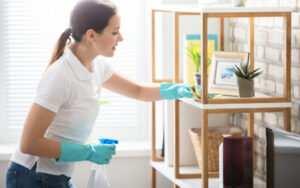
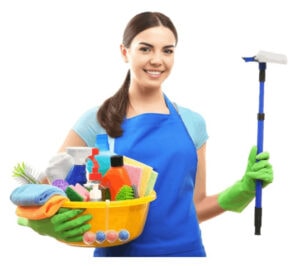
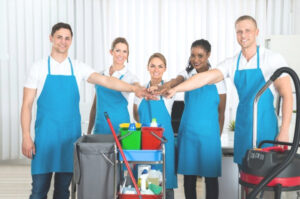

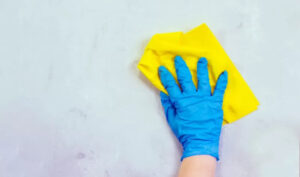

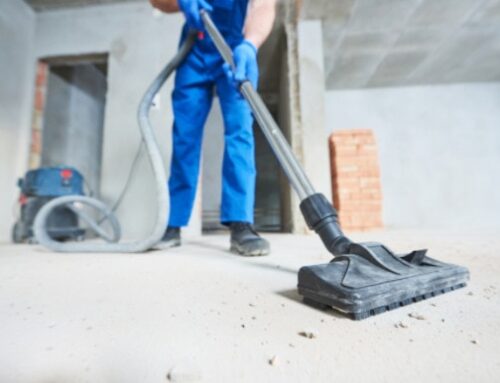
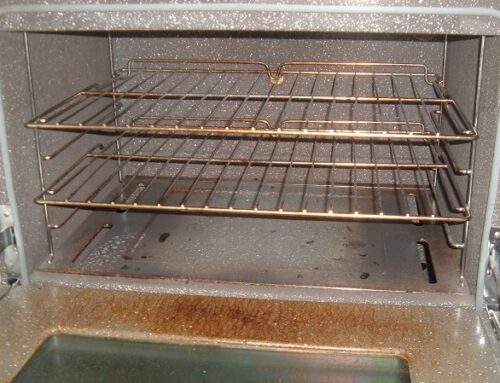
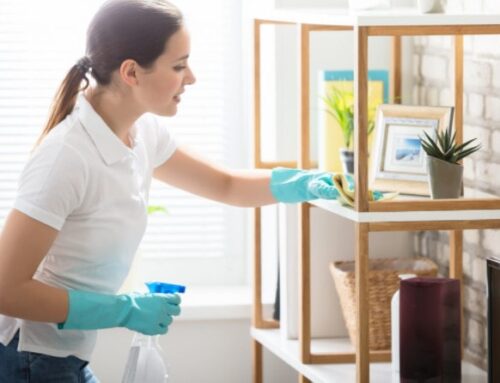
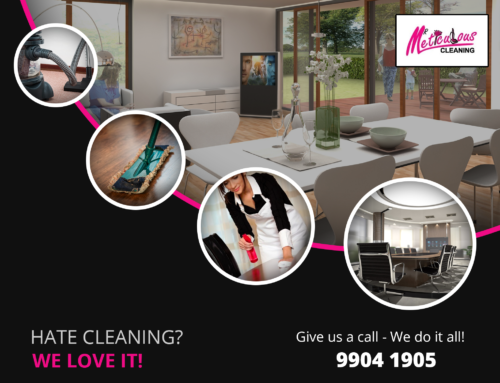

Leave A Comment
You must be logged in to post a comment.